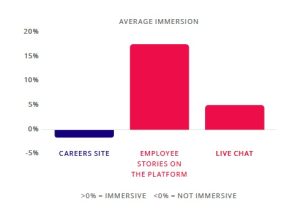We conducted a study with Immersion Neuroscience which examined candidates’ immersion levels during a standard recruitment process. Immersion is measured second by second and is a combination of attention and emotional resonance. It’s the leading indicator of positive outcomes from an experience and is a strong indicator of whether the content presented is persuasive and will lead them to take action — in this context, to apply for a job and accept an offer.
Using participants’ physiological data, such as heart rate and oxytocin levels, we demonstrated that employee stories are 20 percent more immersive than recruiting through career sites alone. The research tested 68 undergraduate students, comparing those who browsed Citi’s careers site only with those who browsed Citi’s careers discussion platform (with featured stories) or participated in a live chat about what it’s like to work at the company.
The experiment revealed some important results, including:
- Employee stories are 20 percent more immersive than career sites, bringing more potential employees into the recruitment process.
- Employee stories drove constant immersion during the 30-minute session, compared to the careers site where interest dropped by over 30 percent after an initial peak.
- Employee stories are 50 percent less frustrating than careers sites and significantly below industry benchmarks for frustration.
- Real-time engagement with employees is the most immersive approach, with 95 percent of participants saying the content was highly relevant or relevant, 77 percent of participants saying their impression of the company improved, and 98 percent of participants saying they would apply for the job.
How to Tell Persuasive Stories That Get Results
We’ve shown that storytelling works for HR, but how do you get started? Effective storytelling isn’t necessarily what employer branding teams believe it is. Many career sites use the same testimonial video format of employees talking about how great it is to work at X company, listing some benefits or perks, and then saying things like, “our team is like a family,” “we work hard and play hard,” or “the best thing about working here is the people.” None of these statements stand out — these testimonials aren’t persuasive.
 According to our own analysis of over 100,000 stories across our platform and research conducted by the Wharton Business School, a persuasive story should have five characteristics:
According to our own analysis of over 100,000 stories across our platform and research conducted by the Wharton Business School, a persuasive story should have five characteristics:
- A narrative — there should be a clear arc to the story
- Authenticity — it should be a real, lived experience
- Detail — avoid being vague or wishy-washy
- Meaningful Challenges — demonstrate how obstacles have been overcome in the role, show candidates how they can grow
- Practical Tips — include some achievable steps or advice for candidates to take
Instead of, “we get flexible time to help us manage our work/life balance,” candidates want a story from Karen in Client Success about how flex time allows her to make the school run without stressing about traffic on her way in.
Instead of Rizwan in PR talking about the “work hard/play hard” culture, candidates want to know that after a particularly busy quarter with a lot of long hours, the team was rewarded with a big drinks celebration for hitting their targets and given two bonus days of holiday … specific examples of the perks and culture of the organization in action.
By telling more detailed, meaningful stories that come straight from your employees, your employer brand is built in an authentic way that persuades the right candidates to take action and apply for a role. Rather than telling candidates who you are, you’re showing them — and they’ll be more likely to listen.
